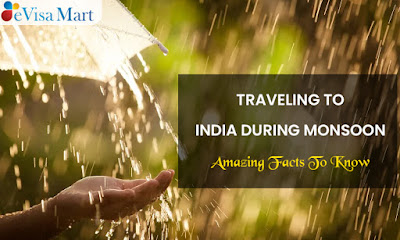Introduction about traveling to India during monsoon:
Nowadays people want to visit India during the monsoon season. But, one should follow the tips before planning their vacation during this season.
Facts to know about monsoon season in India
There are mainly 2 monsoon seasons. One belongs to the Bay of Bengal side and the other belongs to the Arabian Sea. Monsoon generally first hits India in the southern state of Kerala. This generally happens at the beginning of June and then moves north to Mumbai and then to northeast and Delhi. By July all monsoon is experienced all over India. South India receives more amounts as compared to North India. The rain starts slowing down in North India in the month of August but doesn’t leave Mumbai until October. The exception is in the northeast. Here, the monsoon season doesn’t start until September and normally ends in March.
Visa requirement for traveling to India
The traveler should have a valid passport for six months beyond the date of the arrival to obtain the visa.
There should be 2 blank pages in the passports for the staff to stamp.
Foreign tourists need to have a tourist visa for traveling to India.
The tourists can get an e-visa online relatively simply, but it should be kept in mind that the visa is mainly valid from the moment of its issue, rather than the moment the visitor enters the country.
There should be no damage to the passport. The passports should also be machine-readable.
Travel tips to follow during monsoon
Rainy seasons in India are much awaited for the relief, they normally bring from the blazing heat of summer. It is the time when nature’s beauty is at its peak but it also can be a hard time for tourists, in some destinations. It is normally the end of the holiday season. Monsoon not only brings the best of natural beauty but also means significant discounts when it comes to housing and traveling cost. Some of the best tips for tourists are as follows:
While someone is traveling during the monsoon season, it is better to pack well. The clothing items which are essential in the bags are raincoat and the umbrella. Synthetic Clothes are mainly recommended for the travelers as they dry out quickly. One should not forget to carry rain-proof boots and the luggage bags with them.
It is very common to have diseases during the monsoon season. A medical kit is a must in the travel bag with some antibiotics.
One should always carry the mosquito repellent and they should sleep fully-clothed to protect their body against mosquito bites in the night. Fever, cold, and headache are some of the signs of Malaria, so one should be aware of this.
One should be aware of the infected food and water. It could be a monsoon hazard. One should stick to the bottle of boiled or the mineral water, they should eat properly cooked food, and wash the fruits carefully. It is better to stick to some hot beverages such as tea and coffee which are rather safer as compared to cold drinks and juices.
If someone is traveling by a self-owned or hired road vehicle, they should take prior reports about the weather and road conditions of the tourist destination. They should keep the spares handy while traveling long distances.
One should keep the phone numbers of their contacts to call them in case they get stuck in some flooded area in between their destination. One should try to ensure that their family and friends know where they are and where they plan to go next.
Keeping the hairdryer is an added advantage in the monsoon. It helps someone to avoid catching a cold from the wet hair and they can dry their clothes as well.
Places to visit in India during monsoon
Lonavala: This place is full of green environment and is well accompanied by the presence of beautiful waterfalls. One will be able to visit some other places in Lonavala like the Tiger’s Leap, Della Adventure, and Bhushi Dam.
Kodaikanal: This place is located in Tamil Nadu. Kodaikanal located in the state of Tamil Nadu is an awesome place to visit during the monsoon days. One can enjoy many outdoor activities during this time such as walking on the beach, swimming, different water sports, and more.
Andaman and Nicobar: This Island mainly consists of around 570 islands as well as the enchanting wildlife and also thrilling water sports. The sunset and sunrise are the best time to get the best view of the beach.
Coorg: This place is usually covered with the thick and heavy cover of the natural flora and fauna. It is a romantic place for the couples to experience an extensive variety of the waterfalls, lakes as well as the coffee plantations and a lot more. One can do different adventure sports in this season like mountaineering, mountaineering, and camping over there.
Munnar: This is a place located in the state of Kerala which is not much less than heaven in the country. One can visit some other places like Mattupetty Dam, Eravikulam National Park, Anamudi, and more.
Spiti Valley: This place is very popular having the popular name of little Tibet. During the rainy season, the area mainly looks fresh and mesmerizing. The tourists can indulge themselves in river rafting, admiring flora and fauna. The Tibetan dishes like noodles, momo, are one of the tastiest things to have.
Leh-Ladakh: Leh & Ladakh lie near to the Indus valley, at the far-reaching corner of Northern India. During the rainy season, this place looks just amazing and fresh too. This is mainly bounded by two of the world’s most extensive mountain ranges and is mainly surrounded by the subalpine forest. Some of the ancient and historic Buddhist monasteries are also located here like the Shanti Stupa.
Monsoon can be the most refreshing season to travel in India.




